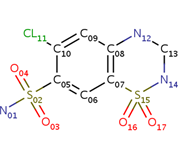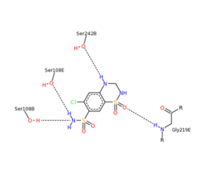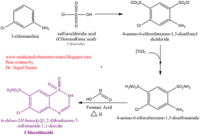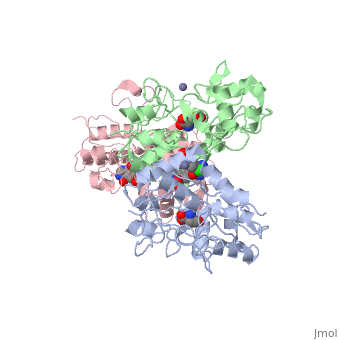Structure
is a semisynthetic chemical compound known chemically as 6-chloro-3,4-dihydro-2H-1,2,4-benzothiadiazine-7-sulfonamide 1,1-dioxide (Figure 1) [1]. It has a chemical formula of C7H8ClN3O4S2 and a molecular weight of 298 Da [1]. This chemical compound consists of a benzothiadiazine, sulfonamide, chloride, dihydro, and dioxide group. It has a melting point of 272 degrees Celsius, a flash point of 302.7 degrees Celsius, a solubility of 60 mg/ml in DMSO and less than 1 mg/ml in water, and appears as a white crystalline powder [2]. The structure was determined by X-Ray diffraction and was measured at a resolution of 2.1 Angstroms [3]. See Ionotropic Glutamate Receptors. . The enzyme cave of glutamate receptor 2 contained that enabled binding of chlorothiazide. Binding involved hydrogen bonding between the (Figure 2) [3]. Synthesis of chlorothiazide occurs through the reaction between 3-chloroaniline, chlorosulfonic acid, and ammonia; and it is catalyzed by formic acid (Figure 3)[4].

Figure 1. Molecular structure of chlorothiazide.

Figure 2. Stabilizing structure between glutamate receptor 2 and chlorothiazide.

Figure 3. Synthesis of chlorothiazide.
Function and Mechanism
Chlorothiazide has diuretic and anti-hypertensive properties. Chlorothiazide acts as a diuretic, which means that it inhibits the reabsorption of chloride. This occurs at the distal tubules via the sodium-chloride co-transporter. The result of this is an increased excretion of sodium, chlorine, and water. Chlorothiazide also inhibits sodium ion transport across the renal tubular epithelium through binding to the thiazide-sensitive sodium-chloride transporter. More specifically, chlorothiazide targets. The result of this is an increase in the excretion of potassium using the sodium-potassium exchange system. As for the anti-hypertensive properties of chlorothiazide, the mechanism is not quite as known. It is thought that vasodilation is caused by the activation of calcium-activated potassium channels (KCa) and the inhibition of carbonic anhydrases[5].
Chlorothiazide targets to perform the reversible hydration of carbon dioxide. is also targeted to perform the reversible hydration of carbon dioxide, regulate the fluid secretion of the anterior chamber of the eye and the intracellular pH in the duodenal upper villous epithelium during proton-coupled peptide absorption, and stimulate the chloride-bicarbonate exchange activity of SLC26A6. Chlorothiazide targets to perform the reversible hydration of carbon dioxide, stimulate the sodium/bicarbonate transporter activity of SLC4A4, and remove acid overload from the retina and retina epithelium [5].
Medical Applications and Relevance
Hypertension
Although Diuril was introduced as an anti-diuretic drug, its anti-hypertensive properties were discovered when two researchers from Boston and Washington D.C administered the drug to patients suffering from congestive heart failure, edema, and severe hypertension, and noted a dramatic reduction in high blood pressure [6]. Unlike other hypotensive drugs that lower blood pressure equally in both hypertensive and normotensive patients, Diuril reduces the blood pressure of patients in the hypertensive state only. It therefore possesses considerable specificity. Diuril was also favored over other hypotensive drugs because of its ease of administration; it could be delivered orally, and required no hospitalization or testing to monitor for immediate adverse effects. When combined with agents such as ganglionic blockers, reserpine, and hydralazine, the drug's efficacy was synergistically increased while its respective toxicities were minimized [7].
Decrease Edema
Diuril functions as a thiazoide diuretic to treat edema in patients diagnosed with cirrhosis of the liver, congestive heart failure, or with disorders associated with the kidney[8]. As a diuretic, Diuril is responsible for inducing fluid loss [9]. Its role in adjunctive therapy is to assist the primary form of treatment in handling symptoms associated with a disease. In some cases, a short-term treatment of Diuril may be used to treat edema occurring during pregnancy associated with hypervolemia that is causing discomfort in the patient[8].
Diabetes Insipidus
Diabetes Insipidus is a rare disorder caused by the kidney’s inability to retain water. There are four different types of diabetes Insipidus; Central, Nephrogenic, Dipsogenic and Gestational. High concentrations of sodium and potassium in the blood are characteristic of all types of Diabetes Insipidus. Treatment with Diuril demonstrates a decrease in saluresis, i.e the excretion of sodium and chloride, within approximately eight hours following its initial dose, and a decrease in kaliuresis, the excretion of potassium ions, approximately fifteen hours following its initial dose.[10].
Kidney Stones
Kidneys are needed to filter fluids and waste from the body to produce urine. Sometimes there are high levels of chemicals in the urine that form crystals and the crystals eventually become large enough to form stones in the kidney [11]. Chlorothiazide can help prevent against calcium kidney stones with patients that have high calcium concentrations in their blood.[12] Thiazides (Diuril is an example of one) can cause potassium loss as well, which reduces citrate levels. Lowered citrate levels can increase the risk of kidney stones, so Diuril needs to be taken in conjunction with potassium-citrate pills [11].
Side Effects
One main side effect that should be noted when taking Diuril is the introduction of purpura, or excessive bruising and superficial bleeding, typically on the legs [13]. There are many different types of purpura, but the general bleeding of small vessels and inflammation hold true. Some patients, when taking Diuril more regularly, as in twice a day for a specific number of weeks, will exhibit purpura. This can be treated typically with bedrest, minor medications, and discontinued use of chlorothiazide. One study from the Mayo Clinic showed that, after discontinuing use of chlorothiazide and then readministering a single dose, purpura reappeared quite rapidly, leading to inferences that chlorothiazide use was what originally brought on the purpura [14].




